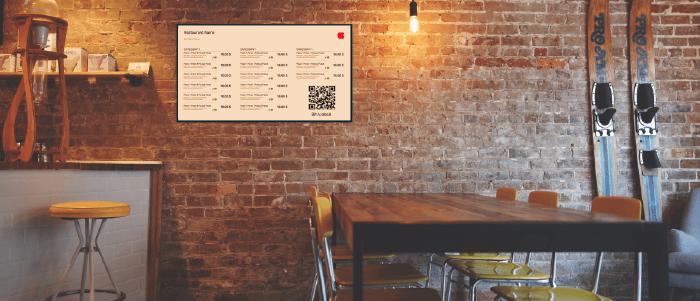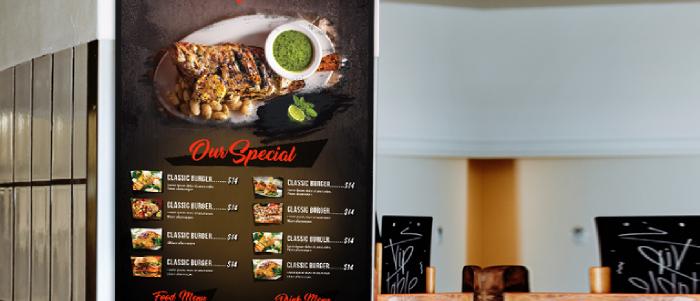
Dec 15 2021
6 min read

Menus often appear to be a tiny and insignificant aspect of any restaurant business. They are underplayed when it pertains to their role in making the dining experience more enjoyable. But the truth is that the presentation of restaurant & QSR menus directly impacts consumer psychology.
Let’s see it with an example.
Suppose, after a lengthy and tedious day at work, you’re craving sushi and scallops. You park your car, and as you’re about to enter the restaurant, you catch a glimpse of delicious pastries on a digital display offered by a pastry shop at the other end of the road. And before you even know it, you completely forget about sushi and scallops, and you’re dying to get a bite of those pastries first.
So, it’s no surprise that customers remember McDonald’s digital screens. Behemoths such as KFC, Domino’s, McDonald’s spend billions of dollars on their alluring digital menus. Other chains such as Panera and Chilis have also joined in on this trend. Subway, another big name in the genre, also has over 20,000 digital screens in its stores throughout Europe.
So, there has to be some underlying marketing strategy that makes spending billions of dollars on digital menu boards a sensible decision.
Earlier, McDonald’s has confirmed that the company has a $6 billion plan in play to redesign most of its sites throughout the United States. This strategy extends to self-service digital kiosks, bright and dynamic digital menus, phone orders, and curb-side takeouts.
If we talk numbers, more than 8000 restaurants around the world are now inclined to employ the use of digital signage. One of America’s most popular fast-food chains, Burger King executed a massive rebranding rollout throughout its 6500 outlets in just a couple of months.
According to statistics, more than half of restaurants have embraced self-service digital kiosks and digital menu boards in the Land of Liberty alone. When we’ve cited statistics, the most pressing question is why such big names of the restaurant business are shifting to digital menu screens. It is paramount to identify why eateries require digital signage screens and how they might contribute to better consumer retention, service, and return on investment.

To keep up with the likes of its rivals such as Subway and Starbucks, who have put big bucks going digital. As a result, their client base, as well as revenue, have skyrocketed. Learning from this, McDonald’s also planned to pursue digital transformation. McDonald’s has responded to the concept by fixating on ensuring the standards of its snacks and vociferously promoting them.
Nevertheless, the company also intended to revamp its consumer engagement and service while transitioning into the digital world. Considering the meal standards and its predefined notions were exceedingly difficult to modify.

Putting into the words of the Chief Executive Officer and President, since the implementation of digital menu boards, “Sales has grown to $3 billion for both McDonald’s company and franchise restaurants globally, and we believe there’s a lot more opportunity to grow.”
Both McDonald’s drive-thrus and restaurants have embraced the use of screen menus. This strategy was put in place owing to a plethora of factors. Specials that upsell and bring in most revenue are emphasized using factors such as local weather, seasons, and, believe it or not, traffic levels.
For a business like McDonald’s, this is a novel technique to reach out to the core of its consumer base.
Also read: How to create a digital menu baord

In the last two years, you’ve likely to have ordered your Happy Meal or Snack Wrap from a McDonald’s screen menu if you’ve stopped or driven through one. In reality, McDonald’s is shifting its focus to a more digital future, and these changes are a facet of that shift.
Known as the “Experience of the Future,” Micky D’s US locations revealed a $6 billion revamp in 2019 — and the top highlight?
New AI-powered digital menu displays in stores and at drive-thrus.
To make things even better, the new system allows them to customize their fast food to their liking, choose extra sides to go and peruse the menu for products they might be interested in.
A 4.8 percent gain in sales was reported for the following year, which was huge. Eateries that have transitioned to electronic menus have also witnessed an average revenue boost of 3-5 percent.
But hey! You don’t have to be a household name to leverage the power of digital menus. Nor do you need an AI to make your customers go ga-ga over your food. A simple digital menu board solution for your restaurant can effectively result in a revenue boost.
A lot of manual tasks can be automated with digital menu board applications. For example, menus can be day-parted and special menus can be scheduled ahead of time, saving the restaurants the cost of time and the trouble of removing outdated menus every time. The digital signage could also show order status and decrease the perceived wait time.
Changes in the menu such as item availability or daily specials can be updated in real-time without the need of any extravagant technology.
Check out: Case study on how HungerBox integrated Pickcel digital signage solution simplifieng order queue management at corporate cafeterias
With paper, it may take several weeks to propel a project from concept to development and evaluation process, to productions and get all the points right and at last its applications in your restaurants. Manual entry of menu items and prices into both POS systems and digital signage can lead to errors. Reducing the need for manual data entry ensures minimizing the risk of mistakes.
Digital menu solutions allows you to make alterations or a complete revamp in a snap of a finger. Is there an error in your printouts? Sadly, mistakes like this do happen a lot, and fixing them will take a bit of time. Correcting a typographical error on your digital menu is as simple as tagging someone in your Instagram posts. In addition, these vibrant and appealing panels allow you to ensure that all of the content is synchronized to a single source.
Addtionally, digital signage software can be integrated with POS systems to automatically update McDonald’s menu board, prices, and availability in real-time based on inventory levels or promotional activities. This automation ensures that the digital menus always display the most current information, reducing the likelihood of customer orders being placed for out-of-stock items or at incorrect prices.
McDonald’s investment in self-ordering kiosks and digital menu boards tackled the issues of productivity by shuffling their employees freely. After deploying digital kiosks, the quick-serve business could direct their counter staff (who answered calls and received the orders) to other jobs that drive revenue and improve service quality.Digital signage platforms often feature scheduling capabilities, allowing restaurants to plan and automate menu changes for different times of the day (e.g., breakfast, lunch, and dinner menus) or special promotions. By linking these schedules with the POS system, restaurants can ensure that their digital menus and POS system are always in sync, improving operational efficiency and customer satisfaction.
Earlier, McDonald’s used to be cramped during meal hours, with the queue so long that it might instantly repel consumers.
Today, the Golden Arches not only offer state-of-the-art customer engagement where they can explore all offers on a giant high-definition screen, but it has also made the food purchase seamless and secure. Customers can order with self-service kiosks and check out quickly without having to depend on an overworked counter staff’s service speed. Short queues equal more customers, which then contributes to increased revenue.
Traditional menus require frequent updates and reprints to reflect changes in items, prices, or branding. Each update incurs printing costs, which can accumulate, especially for establishments that frequently adjust their offerings. Digital menus eliminate these printing costs, as updates can be made digitally at no additional expense beyond the initial investment in the digital signage system. Priting traditional menus can be a significant overhead cost, requiring a complete reprint to correct. Digital menus can be corrected instantly at no additional cost, reducing waste and ensuring that customers always have access to accurate information. This immediate update capability also reduces the potential for customer dissatisfaction and order errors, which can occur when outdated menus are in circulation.
Post the breakout of the COVID-19 pandemic, there has been apprehension among restaurant-goers about physical contact and face-to-face interactions with the restaurant staff. Restaurant kiosks, which facilitate customers to order and pay for their meals at the touch of a button, are an obvious answer to this problem. Customers walking in can make their orders and have them sent immediately to the kitchen via a digital kiosk.
Alternatively, the customers can scan QR codes from restaurants’ digital menu boards and place their orders from mobile phones. The bottom line is that going digital has effectively addressed the health & hygiene challenge during the pandemic.
There’s no lie that these digital menus and self-servicing digital kiosks necessitate an initial outlay that might be tough to rationalize when sales have dropped. Nevertheless, the numbers imply that such digital menus and kiosks will remain in demand for years to come.


Dec 15 2021
6 min read

Aug 23 2021
6 min read

May 31 2021
5 min read

Dec 28 2020
5 min read
Take complete control of what you show on your digital signage & how you show it.
Start Free Trial Schedule My DemoSee How to Boost Sales & Branding with Digital Signage -40% Less Work, Faster Updates, Better Visibility
Unlock Exclusive Insights